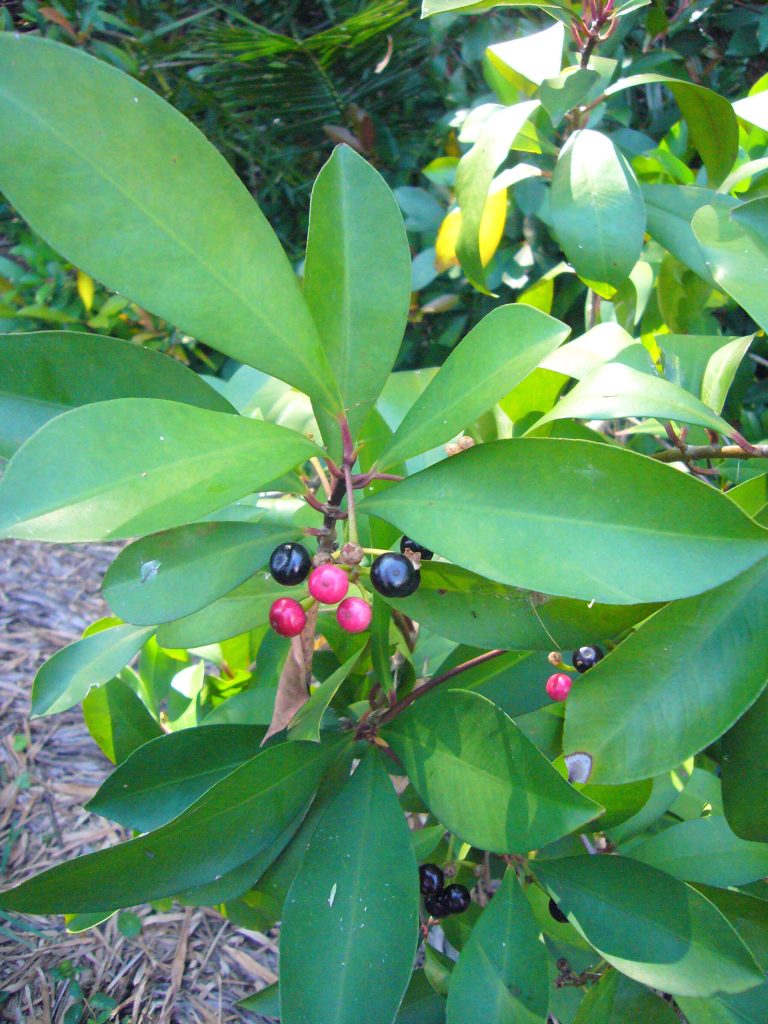
Marlberries while edible are usually low on every ones taste list. Photo by Green Deane
We are definitely into cool season foraging. In classes this week we saw Pellitory, False Hawks Beard and some young Poor Man’s Pepper Grass. We also saw our last Tallow Plum and Grapes for the year. If you look carefully now you can find a few blossoms on the Eastern Red Bud and fruit on the Mullberries. (They often have a token display in the fall, them and Surinam Cherries.) Marlberries, varied as they are, are happy right now and were fruiting heavily in F.t Pierce. The Ardisias are a complex family.
There is the native Marlberry (Ardisia escallonioides) that has edible black fruit that ranges from bad to almost good. There is the invasive Asian, Ardisia elliptica, whose berries are edible but insipid. Another escapee, the Ardisia solanaea, has berries and young leafy shoots that are edible and is a common food in its native range. There is also the self-liberated Ardisea crispa, with edible shoots. Lastly there is the dreaded Ardisia crenata, which is not listed as toxic but some think is potentially toxic. It’s suspected of killing cattle in 2001 and 2007. I ate the flesh off one seed and had no problem. It kind of tasted like a raw pea, but had the texture of a cooked bean. Neither appealing or offensive.
The foragibility of Marlberries is a matter of opinion or how hungry you are. Some think the pulp of the Marlberries taste close to blackberries, grapes or raisins. Others say they are unappealing and acidic. You eat the pulp only, not the seed. It’s called “marlberry” because the shrub grows in marl and it’s a marvel that it survives in marl. Marl is a calcium-rich limestone mud turned into semi-stone that is used for building roads in Florida because it drains well.
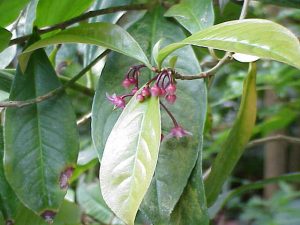
The very edible Ardisia solanaea.
Native marlberries (A. escallonioides) often occur naturally with Sabal Palmettos, the Cabbage Palms. Locally Marlberries are found mid-state and south with more representation along the coasts than inland. You’ll see them in the interior of dense, shady hardwood hammocks, usually under a canopy live oaks and cabbage palms. It’s in the common shrub layer with Wild Coffee (Psychotria nervosa and Psychotria sulzneri) and American Beautyberry Callicarpa americana. Ardisia Elliptica, is on the state’s hit list. It’s very invasive and the fruit edible as well. Nibbling on A. elliptica fruit and destroying the seed is being a good citizen. Lucky you if you find non-native Ardisia solanaea as it is quite edible. The leaves are 7.3% carbohydrates, 31.25% crude protein, 6.6% fiber, no lipids and 154 calories per 100 grams. They have a good amount of vitamin C, about 44.5 mg per 100 grams, which is two-thirds your daily need. Beta-carotene is 240 mg/ml, vitamin E 7.29 mcg/g, and 113 mcg/g of phenols. The minerals are sodium 434.7 mg per 100 grams, potassium 126.3 mg, calcium 769.52 mg, 219.7 mg magnesium, 1.12 mg zinc, and 0.57 mg copper.

Classes are held rain or shine (but not during hurricanes.)
My foraging classes are visiting both coasts this weekend, Largo Saturday and Melbourne Sunday. Cold long-term forecasts co-opted West Palm Beach Thanksgiving weekend rather than Jacksonville.
Saturday November 20th, Eagle Park Lake, 1800 Keene Road, Largo, FL 33771. 9 a.m to noon. Meet at the pavilion by the dog park.
Sunday November 21st, Wickham Park: 2500 Parkway Drive, Melbourne, FL 32935-2335. 9 a.m. to noon. Meet at the “dog park” inside the park
Saturday November 27th, Dreher Park, 1200 Southern Blvd., West Palm Beach, 33405. 9 a.m. to noon. Meet just north of the science center.
Sunday November 28th, Spruce Creek Park, 6250 Ridgewood Ave. Port Orange, 32127. 9 a.m. to noon, meet at the pavilion.
Saturday December 4th, Bayshore Live Oak Park, Bayshore Drive. Port Charlotte. 9 a.m. to noon. Meet at the parking lot of Bayshore and Ganyard St.
Sunday December 5th, Mead Garden: 1500 S. Denning Dr., Winter Park, FL 32789. Meet at the bathrooms. The park entrance is on South Denning. Some GPS directions get it wrong.
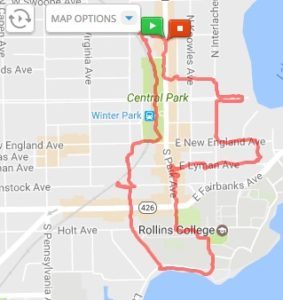
The path of the urban crawl includes Rollins College and Winter Park Library.
My annual Urban Crawl, my twelveth, is coming up on Friday, December 17th, in downtown Winter Park. A reasonable question is what about foraging in a city? There is some surprising research. Dan Brabaner is a geoscience professor at Wellesley College, Boston. With some undergraduate students they studied preserved food collected from fruit trees and the like in the urban Boston area. What they found was cherries, apples, peaches and herbs were relatively low in lead and arsenic. That is, a serving had less amounts of these toxins than the allowed daily amount for a child. The team also did not find a significant difference between peeled and unpeeled fruit. The fruit was low in toxic chemical because they are the furthest away from any toxins in the soil. This would apply to tree nuts as well. Leafy greens faired well, too, because they grow fast and 1) don’t have time to accumulate toxins and 2) most air pollution on them can be washed off. Brabander also analyzed foraged food from plants growing in the urban environment not growing on agricultural soil. These foods had higher micronutrients because they were not growing on worn-out agricultural soil. Calcium and iron were higher as were manganese, zinc, magnesium and potassium. Thus we know that not only do “weeds” pack more of a nutritional punch because they are wild but also because they can be growing in better soil. My Urban Crawl is a free class. We meet in front of Panera’s at 10 a.m. We wander south to the college, stop at Starbucks, go east to the public library area, then back to Panera’s.
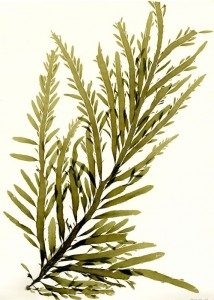
Desmarestia ligulata is not edible.
Non-edible seaweed is uncommon above the equator. The first is Desmarestia ligulata. It is laced with sulfuric acid but is used to make pickles. You’ll know it when you find it because it will burn your mouth. The other in North America (and Central America) non-edible is Cyanobacteria which is found in the Caribbean and linked to ciguarera poisoning. It’s not really a seaweed but is a blue-green algae found in the warmer waters. It is why one should never eat older barracuda. I should add never eat blue-green algae from fresh water either nor fish from a fresh water pond with a lot of blue-green algae. They are not on the menu. As for other parts of the world, there might be some toxic red seaweeds in the South Seas. Since most seaweed is edible, and nutritious, why isn’t it consumed more often? Taste and texture. I’ve collected Sargassum here in Florida and prepared it many ways. Semi-drying and frying isn’t too bad but Bladderwrack is better, Sea Lettuce better still. The latter makes very nice salads. Not surprisingly most land animals including birds don’t like seaweed. However, it does make good mulch and fertilizer. So while one may not use it directly in the diet it can still help sustain you with uses in the garden. During Victorian times it was highly used in English agriculture mostly as mulch and fertilizer. Here are some of my articles on seaweed: Bladderwrack, Caulpera, Codium, Gracilaria, Sargassum, Sea Lettuce, and Tape Seagrass.
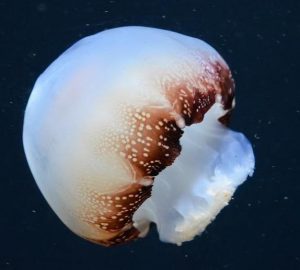
Stomolophus meleagris, one of our edible jellyfish.
While on the topic of the beach — I’m usually there this time of year for a Greek festival, a birthday, and Veterans Day — many jellyfish are edible, including some that are found in local waters. I had a friend from Taiwan who never ordered from the menu at Chinese restaurants. It was always off-the-menu and then after much discussion with the waiter and sometimes the chef. One of those chats produced a dish of jellyfish. I was hooked. It was very tasty and jellyfish can be caught while casting for other fish. (I like castnetting and am a castnet junkie.) While a substantial food I’m not sure jellyfish would qualify as a staple because catching them by hand is by chance (which does increase however when in season.) They are also mostly water and need to be dessicated immediately, not a small process. It all depends on how hungry you are and how many of them you have. You should get them live out of the water, not dead on the beach. To read about jellyfish go here

Green Deane videos are now available on a USB.
My 150-video USB would be a good winter present and is now $99. The 135-DVD set has been phased out. These videos are the same first 150 videos I have on You Tube. Some people like to have a separate copy. The videos on the USB have to be copied to your computer to play. They are MP4 files. My headache is getting my WordPress Order page changed from the older DVD set. If you want to order the USB make a $99 “donation” using the link at the bottom of this page or here. That order form provides me with your address, the amount — $99 — tells me it is not a donation.

Green Deane Forum
Want to identify a plant? Perhaps you’re looking for a foraging reference? You might have a UFO, an Unidentified Flowering Object, you want identified. On the Green Deane Forum we — including Green Deane and others from around the world — chat about foraging all year. And it’s not just about warm-weather plants or just North American flora. Many nations share common weeds so there’s a lot to talk. There’s also more than weeds. The reference section has information for foraging around the world. There are also articles on food preservation, and forgotten skills from making bows to fermenting food.
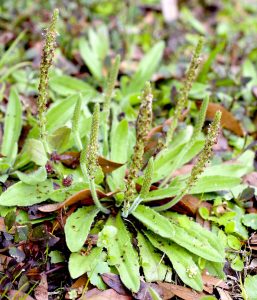
Our little native plantain is ramping up its seasonal appearance. Photo by Green Deane
This is weekly newsletter #482. If you want to subscribe to this free newsletter you can find the sign-up form in the menu at the top of the page.
To donate to the Green Deane Newsletter click here.

